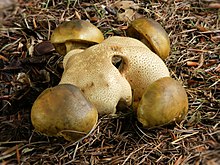Parasitic boletus
| Parasitic boletus | ||||||||||||
|---|---|---|---|---|---|---|---|---|---|---|---|---|

Parasitic boletus ( Pseudoboletus parasiticus ) on thick-skinned potato bovist ( Scleroderma citrinum ) |
||||||||||||
| Systematics | ||||||||||||
|
||||||||||||
| Scientific name | ||||||||||||
| Pseudoboletus parasiticus | ||||||||||||
| ( Bull .: Fr. ) Šutara |
The parasitic boletus ( Pseudoboletus parasiticus , syn. Xerocomus parasiticus ), also called parasitic bolete or parasitic felt bolete , is a rare species of fungus that grows as a parasite exclusively on potato bovists, but is also able to develop ectomycorrhizae .
features

His hat is 1–8 cm wide, finely felted, dry and light olive brown. Its tubes are sandy-brown to dirty-olive, its stem is slender, gray-yellow, always curved, as it grows around the host and tapers towards the base. Its pores are very wide, the flesh is whitish and not blue. The fruiting bodies appear gregarious to tufted, often in groups on a potato bovist.
Ecology and phenology
The Parasitic Röhrling is usually considered a parasite on potato bovists. In culture, however, it forms ectomycorrhizae when its mycelium has been brought into contact with pine roots. However, the parasitic boletus infects the rhizomorphs of potato bovists with its mycelium , grows in the rhizomorphs in the direction of the host fruiting bodies and infects them in order to develop fruiting bodies themselves. He prefers the thick-skinned potato bovist , finds on other species of the genus Scleroderma are rare. It is a pronounced acid indicator and prefers sandy soils, but does not make any special demands on the water supply. It can be found in dry, heather-like biotopes as well as on the edge of moors. It occurs in various forest types up to acidic spruce forests.
The fruiting bodies appear in Central Europe mostly in August and September.
distribution
The Parasitic Boletus is common all over Europe, it is probably also found in North America and North Africa.
Danger
The species is classified as critically endangered in the Red Lists of Endangered Large Mushrooms of Hesse and North Rhine-Westphalia (Category 2), and in the Red Lists of Endangered Large Mushrooms in Bavaria as Endangered (Category 3). In Austria, however, the number of reported sites is increasing, which is why the Parasitic Boletus is not classified as endangered in the Red List of Fungi in Austria.
Systematics
The Parasitic Röhrling shares the way of life to parasitize on representatives of the Sclerodermatineae with Pseudoboletus astraeicola . Together they form the small genus of the parasitic boletus, which is basal within the Boletaceae. Despite the superficial similarity, the parasitic boletus are not closely related to other felted boletus-like genera (e.g. Xerocomus , Xerocomellus etc.).
meaning
In contrast to its poisonous host mushroom , it is non-toxic, but its value as an edible mushroom is controversial and questionable with regard to the endangerment.
swell
literature
- German Josef Krieglsteiner (Eds.), Andreas Gminder , Wulfard Winterhoff: Die Großpilze Baden-Württemberg . Volume 2: Stand mushrooms: inguinal, club, coral and stubble mushrooms, belly mushrooms, boletus and deaf mushrooms. Ulmer, Stuttgart 2000, ISBN 3-8001-3531-0 .
Individual evidence
- ↑ a b Pseudoboletus parasiticus. (Bull.) Šutara, Česká Mykol. 45 (1-2): 2 (1991). In: Index Fungorum / speciesfungorum.org. Retrieved April 11, 2012 .
- ↑ a b D.L. Richter, JL Bruhn: Pinus resinosa ectomycorrhizae: seven host-fungus combinations synthesized in pure culture . Ed .: Symbiosis. tape 7 , 1989, pp. 211-228 .
- ^ S. Raidl: Studies on the ontogeny of rhizomorphs of ectomycorrhizas . In: Biblioth. Mycol. tape 169 , 1997, pp. 1-184 .
- ↑ Ewald Langer: Red list of large mushrooms in Hesse . First version. Ed .: Hessian Ministry for the Environment, Agriculture and Forests, Department of Public Relations and Environmental Education. 2000, ISBN 3-89274-210-3 , pp. 91 ( PDF; 539 kB ).
- ↑ Irmgard Sonneborn, Willi Sonneborn, Klaus Siepe: Red list of the endangered large mushrooms (macromyzetes) in North Rhine-Westphalia . 1st version. Ed .: State Office for Nature, Environment and Consumer Protection North Rhine-Westphalia. 1999, p. 271 ( PDF; 1.08 MB ). PDF; 1.08 MB ( Memento of the original from May 14, 2014 in the Internet Archive ) Info: The archive link has been inserted automatically and has not yet been checked. Please check the original and archive link according to the instructions and then remove this notice.
- ↑ Peter Karasch, Christoph Hahn: Red List of Endangered Large Mushrooms in Bavaria . Ed .: Bavarian State Office for the Environment. 2009, p. 1–108 ( bayern.de [PDF]).
- ↑ Wolfgang Demon, Irmgard Krisai-Greilhuber: Die Pilze Österreichs Directory and Red List 2016. Part: Makromyzeten . Ed .: Austrian Mycological Society. Vienna, Austria 2017, ISBN 978-3-9504410-0-0 , pp. 1-610 .
- ^ Josef Šutara: Xerocomus sl in the light of the present state of knowledge . In: Czech Mycology . tape 60 , no. 1 , 2008, p. 29-62 .
- ^ A b Mitchell E. Nuhn, Manfred Binder, Andy FS Taylor, Roy E. Halling, David S. Hibbett: Phylogenetic overview of the Boletineae . In: Fungal Biology . tape 117 , no. 7-8 , July 2013, pp. 479-511 , doi : 10.1016 / j.funbio.2013.04.008 ( elsevier.com [accessed April 1, 2020]).
